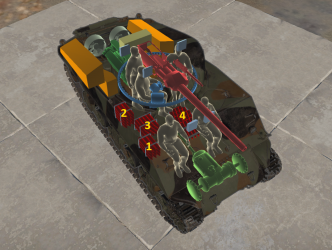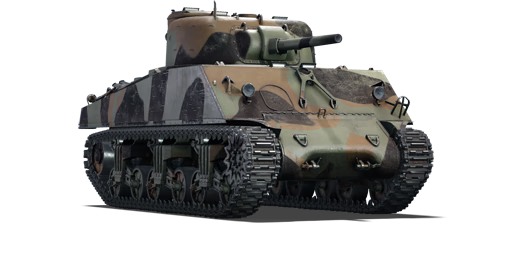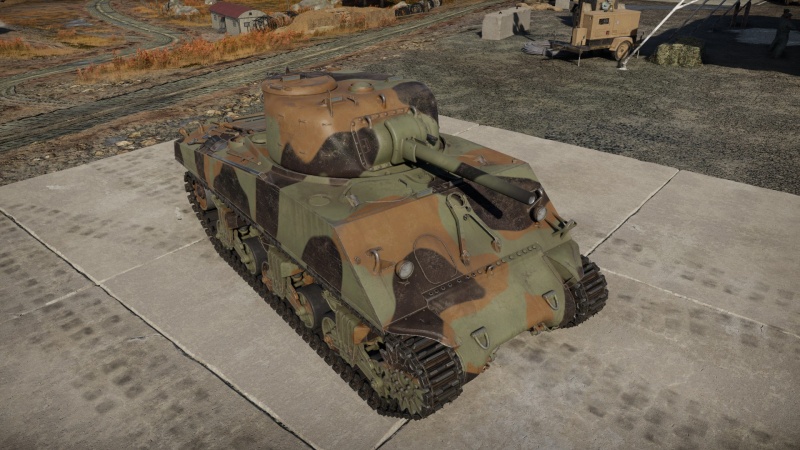Sherman III/IV
| This page is about the Swedish medium tank Sherman III/IV. For other versions, see M4 Sherman (Family). |
Contents
Description
The Stridsvagn Sherman III/IV is a premium rank III Swedish medium tank with a battle rating of 3.7 (AB/RB/SB). It was introduced in Update "La Royale".
General info
Survivability and armour
The Sherman III/IV has a similar armour profile to the M4A2, but without the additional side armour squares, and also due to the lack of a hull machine gun, it loses the MG-port weak spot. It still has the spot of thinner armour on the front of the turret (area ground out to fit the stabilizer) that most of the other 75 Shermans have.
Armour type:
| Armour | Front (Slope angle) | Sides | Rear | Roof |
|---|---|---|---|---|
| Hull | 63.5 mm (46°) Front glacis 63.5-108 mm (2-55°) Transmission area |
38.1 mm | 38.1 mm (23-43°) | 19.5 mm |
| Turret | 50.8-76.2 mm (10-41°) Turret front 50.8 mm (4-32°) Gun mantlet |
51 mm | 51 mm | 19.5 mm |
| Cupola | 51 mm | 51 mm | 51 mm | 19.5 mm |
Notes:
- Suspension wheels are 15 mm thick, the bogies are 10 mm, and the tracks are 20 mm thick.
- Upper front plate has consistent thickness due to lack of MG port weak spot
- A small patch on the turret front right side is thinner (51 mm) than the rest (76 mm).
- Driver and Machine gunner hatches are 25.4 mm thick
Mobility
Even though the Sherman III/IV is on the slower side in terms of Shermans, its mobility is still good, with a quick acceleration and a high top speed. Due to a lack of neutral steering, turning in this tank can be slow from stationary.
| Game Mode | Max Speed (km/h) | Weight (tons) | Engine power (horsepower) | Power-to-weight ratio (hp/ton) | |||
|---|---|---|---|---|---|---|---|
| Forward | Reverse | Stock | Upgraded | Stock | Upgraded | ||
| Arcade | 47 | 7 | 32.5 | 775 | 954 | 23.85 | 29.35 |
| Realistic | 42 | 6 | 442 | 500 | 13.6 | 15.38 | |
Modifications and economy
Armaments
Main armament
75 mm M3 gun is a competent, well-handling gun for a medium tank. Even without any modifications, its ability to fulfil its role, though where it begins to shine is with the M61 shot. Default, M72, suffers from issues typical to US and British solid shots - poor post-penetration effects. This means it's preferable to take down enemy gunner first, usually by hitting the right side of the turret.
| 75 mm M3 | Turret rotation speed (°/s) | Reloading rate (seconds) | |||||||||||
|---|---|---|---|---|---|---|---|---|---|---|---|---|---|
| Mode | Capacity | Vertical | Horizontal | Stabilizer | Stock | Upgraded | Full | Expert | Aced | Stock | Full | Expert | Aced |
| Arcade | 66 | -10°/+25° | ±180° | Vertical | 22.8 | 31.6 | 38.4 | 42.5 | 45.2 | 6.50 | 5.75 | 5.30 | 5.00 |
| Realistic | 14.3 | 16.8 | 20.4 | 22.6 | 24.0 | ||||||||
Ammunition
| Penetration statistics | |||||||
|---|---|---|---|---|---|---|---|
| Ammunition | Type of warhead |
Penetration @ 0° Angle of Attack (mm) | |||||
| 10 m | 100 m | 500 m | 1,000 m | 1,500 m | 2,000 m | ||
| M72 shot | AP | 91 | 88 | 78 | 67 | 57 | 49 |
| M48 shell | HE | 10 | 10 | 10 | 10 | 10 | 10 |
| M61 shot | APCBC | 104 | 102 | 93 | 84 | 75 | 68 |
| Shell details | ||||||||||||
|---|---|---|---|---|---|---|---|---|---|---|---|---|
| Ammunition | Type of warhead |
Velocity (m/s) |
Projectile mass (kg) |
Fuse delay (m) |
Fuse sensitivity (mm) |
Explosive mass (TNT equivalent) (g) |
Ricochet | |||||
| 0% | 50% | 100% | ||||||||||
| M72 shot | AP | 619 | 6.3 | - | - | - | 47° | 60° | 65° | |||
| M48 shell | HE | 463 | 6.3 | 0.2 | 0.1 | 666 | 79° | 80° | 81° | |||
| M61 shot | APCBC | 618 | 6.79 | 1.2 | 14 | 63.7 | 48° | 63° | 71° | |||
| Smoke shell characteristics | ||||||
|---|---|---|---|---|---|---|
| Ammunition | Velocity (m/s) |
Projectile mass (kg) |
Screen radius (m) |
Screen deploy time (s) |
Screen hold time (s) |
Explosive mass (TNT equivalent) (g) |
| M89 | 259 | 3 | 9 | 5 | 20 | 50 |
Ammo racks

| Full ammo |
1st rack empty |
2nd rack empty |
3rd rack empty |
4th rack empty |
Visual discrepancy |
|---|---|---|---|---|---|
| 66 | 57 (+9) | 45 (+21) | 24 (2) | 1 (+65) | No |
Notes:
- First stage ammunition is 23 rounds.
- To enter battle with the sponsons empty bring 45 (+21) shells (1st and 2nd racks empty).
Machine guns
The machine gun on this tank is a general-purpose 7.62 mm M1919A4 Browning machine gun mounted in the coaxial position. A typical machine gun not too unlike on many other vehicles, the machine gun is just average. You will not be able to damage much besides sniping crew in open top vehicles.
| 7.62 mm M1919A4 | ||||
|---|---|---|---|---|
| Mount | Capacity (Belt) | Fire rate | Vertical | Horizontal |
| Coaxial | 3,000 (250) | 500 | - | - |
Usage in battles
The Sherman is an effective medium-range combat tank. Equipped with a fast-firing 75 mm gun and with good handling characteristics, this tank can be an extremely useful asset in most battles.
In battle the Sherman performs well as an all-rounder; the thick turret front and 10 degrees of gun depression make the tank ideal for taking hull-down positions which protect the thinner hull armour from being penetrated by enemy fire. The sloped front upper glacis, when angled, also provides good protection against enemy fire. The reasonable mobility of the Sherman makes flanking a viable tactic. The main weakness of the Sherman is the side armour - not only is it vertical and thin, but behind it most of the ammunition is stowed. The tall silhouette of the tank also makes finding suitable cover difficult. Overall, the M4 Sherman can be considered as an armoured jack-of-all-trades - it will serve a tanker well, however it will not excel in any particular role.
In battle, try to use terrain as cover. Hull-down positions are especially strong in the Sherman, as it has a good 10 degrees of gun depression. The gun mantlet and turret are reasonably strong, but avoiding shots is still the best strategy. In this respect, a hull-down position hides the vulnerable hull. If this is not available, then angling the hull armour to present a greater slope is often a good idea, as this can bounce some low-powered cannon at any range and at longer ranges, render the hull impenetrable.
Another way to play the Sherman is to tap into its traditional cavalry role, its mobility. The Sherman is a great flanker as it is fast enough to get the jump on the enemy's side. Defeat the enemy at their weak front lines or go around the entire enemy force. Once in position at their sides or rear, ambush them. Ideally, the enemy should be too busy focusing on allies attacking in the front to notice the Sherman immediately. Take out the weaker light or medium tanks, the 75 mm gun is not very ideal against heavy tanks like the KV-1 so take out its friends to allow allies more room to outmanoeuvre the KV tank. An organized attack will increase the chances of success on the battlefield.
Enemies worth noting:
M4A2/M4A4 (1st PTG): these Sherman tanks are widely used by both the Allied and the Axis side, so no matter which nation you play they can be quite tough to destroy in the hands of a skilled tanker. Given the rather weak penetration of your short 75 mm gun, their hull can be almost impossible to penetrate when angled, hull down or 300 m away. For an M4A4, there are 2 apparent bulges on the upper front plate, a penetration through there can guarantee a knock out most of the time. But in case the opponent covers them up or when it's an M4A2, aim for the middle parts of the gun mantlet or the turret armour unprotected by the mantlet, you can at least make them defenceless. Note that their guns are equally weak against you, so wiggle around to disrupt their aim while you reload, you have a good chance of bouncing some shells.
KV-1 and variants - A vehicle that the M4 Sherman will have trouble against is the KV-1. While the L-11 is underpowered, the ZiS-5 is potent enough to punch through the Sherman's front, and the Sherman is unable to penetrate the KV-1's thick frontal armour. If this heavy tank is encountered, try to shoot it in its sides and rear, where its armour is thinner and unsloped, though it will still have to be at a close range to penetrate the armour. In addition, shots to the sides will most likely hit fuel tanks or ammunition storage, causing a fire or ammunition detonation and at best, time to reassess the situation.
Churchill heavy tanks - The Churchills, with their complex hulls and sturdy turrets, can be quite hard to penetrate at range. Again, manoeuvre as close to them as possible, the ideal distance being no more than 200 m. If they are angling their hull but facing their turret at you, only go for the turret. For the Mk I Churchills, aim at the near-vertical part of their rounded cheeks to ensure successful penetrations. For the Mk III and the German Churchill, also aim for their flat turret which is at most 89 mm. The shell should go in easily and knock out most, if not all of the crew. Only when you are facing their hull without any angles should you shoot the hull, otherwise shoot the turret only, as their big tracks can easily get in front of the frontal hull. The side hull have multiple layers of armour, some of which are weirdly angled and can absorb plenty of shells.
Pz.IV F2/G/H/J - The historical nemesis of any Sherman, the Panzer IV is one of the Shermans biggest threats at this rank. The long barrel 75 mm gun will easily penetrate the Sherman from the front. The F2 variant is admittedly easy to deal with. A single APCBC to its hull or turret should end it pretty quickly, even at long range. The other variants are slightly harder to deal with. They have thicker hull armour, at 80 mm, which will be much harder to penetrate with the APCBC over 500 m. Luckily the turret armour remains the same at 50 mm. Either aim here with APCBC or sacrifice damage potential and use the AP round to penetrate the hull.
StuG III F/G - Another historical nemesis of the Sherman, and another big threat. The StuG III packs the same punch as the Panzer IV line with its long barrel 75 mm gun, whilst losing the turret, which turns out to be both an advantage and a disadvantage. Lacking a turret means that it will have to traverse the whole vehicle to target an enemy, but it also means that it has a lower profile. The StuG's armour profile is also more complex than the Panzer IV, with less flat areas. Certain areas are sloped and very bouncy. Luckily, there is a big weak spot. There are two flat plates on the front of the hull. The flat plate on the right is the drivers port. Shoot that and you are able to incapacitate the driver, gunner and loader in one go. This is a very efficient way to destroy this vehicle. With the F variant, you can use APCBC to instantly knock out this vehicle with a single shot. With the G variant, it is more reliable to use AP at ranges within 500 m to ensure penetration.
8,8 cm Flak 37 Sfl. - This German half-track is armed with a potent 88 mm gun that can easily knock you out in one shot. However, the gun has a long reload and the half-track has literally no armour to speak of. Also, its crew members are spread out so you're going to need multiple shots to put it down. The shell you should use while dealing with this is of course your HE shell, packed with over 600 g of explosive. First, you take out the gun. The HE shell will also knock out most of the crew members around it too, as an added bonus. Then, take out the two crew members in front of the Flak 37. This may require some more careful aiming, but if you manage to get a good shot, it will likely destroy the vehicle immediately.
Pros and cons
Pros:
- Excellent gun depression of -10° plus the angled frontal turret allows it to utilise hills very well
- Great firepower: adequate penetration and post-penetration damage when using M61 shells; can frontally penetrate and knock out most opponents
- Great turret traverse speed allows it to deal with multiple threats easily
- Well angled frontal hull provides protection against small calibre / low-penetration guns (e.g. 75 mm M3, 50 mm KwK39), and even large calibre guns when angled correctly.
- Adequate top speed allows it to get to positions in time, or to do tactical manoeuvres like flanking
- Fitted with a vertical stabilizer, allowing more accurate fire on the move compared to other tanks, as well as better usage of shoot-n-scoot tactics
Cons:
- Large profile and weak side armour; flankers like the Sd.kfz.234/2 can easily see and penetrate it
- Frontal armour is still inadequate, will get penetrated and knocked out by tanks like Pz.IV F2/G, StuG III F/G, M10 by a single shot
- The M61 shell struggle to penetrate angled targets like StuG III G, Churchill Mk.III or even the T-34 and M10
- Hull traverse is quite slow, making it sluggish in a turn. Also the narrow tracks offer poor ground flotation, thus poor off-road capabilities. Can only reach its top speed on paved or hard surfaces
- Roof armour of 19.5 mm thick is vulnerable to airstrikes with AP cannons. For example the widely used MG151 15/20 mm
- Lack of M2 Browning machine gun seen on most other Shermans means anti-aircraft defense is weak and removes the extra option for taking out lighter vehicles or shooting off tracks without having to use your main gun.
History
After World War II, Sweden purchased a few surplus Sherman tanks from Britain for evaluation and to learn about foreign tank design. They were tested in field conditions. All of the Shermans did quite well in the tests and were praised for their reliability and ease of use even with inexperienced drivers, and while not being made for the winter conditions they were testing in. Even though the tank was viewed favourably, Swedish never fully adopted the Sherman nor did the examples they did obtain see combat service. Inability to purchase more with sufficient spare parts, and other better vehicles being available may be some of the reasons for this decision. The tallness of the Sherman, and the weaknesses brought with that height were a partial inspiration for the future Strv 103 which was focused on minimizing height.
Media
Excellent additions to the article would be video guides, screenshots from the game, and photos.
See also
Links to the articles on the War Thunder Wiki that you think will be useful for the reader, for example:
- reference to the series of the vehicles;
- links to approximate analogues of other nations and research trees.
External links
References
- Swedish Evaluation of the Sherman: http://tanks.mod16.org/2016/09/30/swedish-impressions-of-the-sherman/
| Sweden medium tanks | |
|---|---|
| Strv m/42 | Lago I · Strv m/42 EH · Ikv 73 · Strv m/42 DT · Pvkv IV |
| Centurion derivatives | Strv 81 · Strv 81 (RB 52) · Strv 101 · Strv 104 · Strv 105 |
| Strv 103 | Strv 103-0 · Strv 103A · Strv 103С |
| Strv 121/122 | Strv 121 · Christian II · Strv 122A · Strv 122B PLSS · Strv 122B+ |
| Other | Sherman III/IV · T 80 U |
| Finland | |
| WWII | ▄T-28 · ▄T-34 · ▄Pz.IV · ▄T-34-85 |
| Post War | ▄Comet I · ▄Charioteer Mk VII · ▄T-54 · ▄T-55M · ▄T-72M1 · ▄Leopard 2A4 · ▄Leopard 2A6 |
| Norway | Leopard 1A5NO2 |
| Sweden premium ground vehicles | |
|---|---|
| Light tanks | ▄T-26E · Strv m/39 · Pbil m/40 · Strv m/41 S-I · CV 9035DK · CV 90105 |
| Medium tanks | Sherman III/IV · Strv 81 (RB 52) · Strv 103-0 · Leopard 1A5NO2 · Christian II |
| Heavy tanks | ▄KV-1 m1942 · Kungstiger |
| Tank destroyers | Ikv 73 · SAV 20.12.48 · VIDAR |





